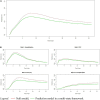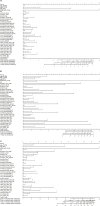Predicting COVID-19 progression in hospitalized patients in Belgium from a multi-state model
- PMID: 36507535
- PMCID: PMC9727386
- DOI: 10.3389/fmed.2022.1027674
Predicting COVID-19 progression in hospitalized patients in Belgium from a multi-state model
Abstract
Objectives: To adopt a multi-state risk prediction model for critical disease/mortality outcomes among hospitalised COVID-19 patients using nationwide COVID-19 hospital surveillance data in Belgium.
Materials and methods: Information on 44,659 COVID-19 patients hospitalised between March 2020 and June 2021 with complete data on disease outcomes and candidate predictors was used to adopt a multi-state, multivariate Cox model to predict patients' probability of recovery, critical [transfer to intensive care units (ICU)] or fatal outcomes during hospital stay.
Results: Median length of hospital stay was 9 days (interquartile range: 5-14). After admission, approximately 82% of the COVID-19 patients were discharged alive, 15% of patients were admitted to ICU, and 15% died in the hospital. The main predictors of an increased probability for recovery were younger age, and to a lesser extent, a lower number of prevalent comorbidities. A patient's transition to ICU or in-hospital death had in common the following predictors: high levels of c-reactive protein (CRP) and lactate dehydrogenase (LDH), reporting lower respiratory complaints and male sex. Additionally predictors for a transfer to ICU included middle-age, obesity and reporting loss of appetite and staying at a university hospital, while advanced age and a higher number of prevalent comorbidities for in-hospital death. After ICU, younger age and low levels of CRP and LDH were the main predictors for recovery, while in-hospital death was predicted by advanced age and concurrent comorbidities.
Conclusion: As one of the very few, a multi-state model was adopted to identify key factors predicting COVID-19 progression to critical disease, and recovery or death.
Keywords: Belgium; COVID-19; hospital data; multistate modelling; risk prediction model.
Copyright © 2022 Mertens, Serrien, Vandromme and Peñalvo.
Conflict of interest statement
The authors declare that the research was conducted in the absence of any commercial or financial relationships that could be construed as a potential conflict of interest.
Figures




References
-
- Sciensano. COVID-19 Epidemiologische Situatie. Brussel: Sciensano; (2021).
-
- Lu J, Hu S, Fan R, Liu Z, Yin X, Wang Q, et al. ACP risk grade: a simple mortality index for patients with confirmed or suspected severe acute respiratory syndrome coronavirus 2 disease (COVID-19) during the early stage of outbreak in Wuhan, China. medRxiv [Preprint]. (2020). 10.1101/2020.02.20.20025510 - DOI
-
- Bello-Chavolla OY, Bahena-Lopez JP, Antonio-Villa NE, Vargas-Vázquez A, González-Díaz A, Márquez-Salinas A, et al. Predicting mortality due to SARS-CoV-2: a mechanistic score relating obesity and diabetes to COVID-19 outcomes in Mexico. medRxiv [Preprint]. (2020). 10.1101/2020.04.20.20072223 - DOI - PMC - PubMed
LinkOut - more resources
Full Text Sources
Research Materials
Miscellaneous

